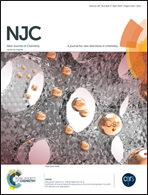Synthesis, crystal structure, optical and electrochemical properties of novel diphenylether-based formazan derivatives†
Abstract
In this study, formazans 5a–5h were synthesized by coupling the reactions of substituted phenylhydrazone compounds 3a–3h with diazonium salt of 4-chloro-2-phenoxybenzenamine (4). The substituted phenylhydrazones 3a–3h were obtained from the condensation of substituted phenylhydrazines 1a–1h with 4-methoxybenzaldehyde (2). The structures of the formazans were characterized by using elemental analysis, FTIR, 1H NMR, 13C NMR, LC-MS and the crystal structure of compound 5e was determined by X-ray crystallography. The absorption spectra of all compounds were investigated in various solvents. Although their absorption bands are only slightly dependent on the polarities of solvents, the significant change was observed by altering the electronic characteristics of the substituents. The fluorescence quantum yield properties and Stokes shifts of compounds 5a–5h in DMSO were also explored. Electrochemical properties of the new products were studied by CV measurements. In addition, computational studies were conducted at the PBE1PBE/6-311g (2d,2p) level to shed light on the structures of possible tautomers and intramolecular H-bonds.


 Please wait while we load your content...
Please wait while we load your content...